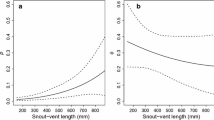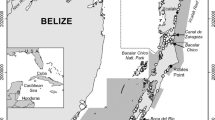Abstract
Capture-mark-recapture (CMR) is commonly used in conservation biology, but rarely used to study non-native species in freshwater habitats. The power of CMR lies in the ability to go beyond simple density estimates and to quantify invasion dynamics and vital population parameters. I applied CMR to a population of the non-native Chinese mystery snail (Cipangopaludina chinensis, Viviparidae) in a 1.46 ha pond on Long Island, NY to estimate population size and survival probability in the waterbody and to uncover potential mechanisms for enormous differences in introduction success within and between waterbodies (observed densities range <1–40 individuals m−2). The C. chinensis population increased from approximately 150 to nearly 970 individuals from 2010 to 2012. Daily capture probabilities were low (<0.2) for snails of all sizes. Daily survival probabilities were size-dependent (almost 1.0 for snails larger than 30 mm shell length, and decreasing below that threshold), suggesting size-dependent mortality. This study highlights the ease of applying CMR to C. chinensis and its potential for other non-native species. Traditional survey methods such as density estimates with transects or quadrats cannot document increasing population sizes or size-specific mortality factors, which are essential for understanding introduction success and dynamics.




Similar content being viewed by others
References
Branson, B. A., 1977. The Chinese apple snail, Cipangopaludina chinensis, on Orcas Island, Washington. The Nautilus 91: 76–77.
Bouska, W. W. & C. P. Paukert, 2010. Effects of visible implant elastomer mark colour on the predation of red shiners by largemouth bass. Fisheries Management and Ecology 17: 294–296.
Carpenter, S. R., E. H. Stanley & M. J. Vander Zanden, 2011. State of the world’s freshwater ecosystems: physical, chemical, and biological changes. Annual Review of Environment and Resources 36: 75–99.
Carvalho, D. D., P. A. Collins & C. J. De Bonis, 2013. The mark-recapture method applied to population estimates of a freshwater crab on an alluvial plain. Marine and Freshwater Research 64: 317–323.
Chaine, N. M., C. R. Allen, K. A. Fricke, D. M. Haak, M. L. Hellman, R. A. Kill, K. T. Nemec, K. L. Pope, N. A. Smeenk, B. J. Stephen, D. R. Uden, K. M. Unstad & A. E. VanderHam, 2012. Population estimate of Chinese mystery snail (Bellamya chinensis) in a Nebraska reservoir. BioInvasions Records 1: 283–287.
Chao, A. & R. M. Huggins, 2005. Classical closed-population capture-recapture models. In Amstrup, S. C., T. L. McDonald & B. F. J. Manly (eds), Handbook of Capture-Recapture Analysis. Princeton University Press, Princeton: 22–36.
Galatowitsch, S. M., N. O. Anderson & P. D. Ascher, 1999. Invasiveness in wetland plants in temperate North America. Wetlands 19: 733–755.
Gosselin, L. A. & P. Qian, 1997. Juvenile mortality in benthic marine invertebrates. Marine Ecology Progress Series 146: 265–282.
Gurevitch, J., G. A. Fox, G. M. Wardle, Inderjit & D. Taub, 2011. Emergent insights from the synthesis of conceptual frameworks for biological invasions. Ecology Letters 14: 407–418.
Henry, P. & P. Jarne, 2007. Marking hard-shelled gastropods: tag loss, impacts on life-history traits, and perspectives in biology. Invertebrate Biology 126: 138–153.
Huggins, R. M., 1989. On the statistical analysis of capture experiments. Biometrika 76: 133–140.
Huggins, R. M., 1991. Some practical aspects of a conditional likelihood approach to capture experiments. Biometrics 47: 725–732.
Johnson, P. T. J., J. D. Olden, C. T. Solomon & M. J. Vander Zanden, 2009. Interactions among invaders: community and ecosystem effects of multiple invasive species in an experimental aquatic system. Oecologia 159: 161–170.
Jokinen, E. H., 1982. Cipangopaludina chinensis (Gastropoda: Viviparidae) in North America, a review and update. The Nautilus 96: 89–95.
Karatayev, A. Y., L. E. Burlakova & D. K. Padilla, 1998. Physical factors that limit the distribution and abundance of Dreissena polymorpha (Pall.). Journal of Shellfish Research 17: 1219–1235.
Karatayev, A. Y., L. E. Burlakova, D. K. Padilla, S. E. Mastitsky & S. Olenin, 2009. Invaders are not a random selection of species. Biological Invasions 11: 2009–2019.
Kolar, C. S. & D. M. Lodge, 2001. Progress in invasion biology: predicting invaders. Trends in Ecology & Evolution 16: 199–204.
Lodge, D. M., M. W. Kershner, J. E. Aloi & A. P. Covich, 1994. Effects of an omnivorous crayfish (Orconectes rusticus) on a freshwater littoral food web. Ecology 75: 1265–1281.
Manly, B. F. J., T. L. McDonald & S. C. Amstrup, 2005. Introduction to the handbook. In Amstrup, S. C., T. L. McDonald & B. F. J. Manly (eds), Handbook of Capture–Recapture Analysis. Princeton University Press, Princeton: 1–22.
Mares, M. A., K. E. Streilein & M. R. Willig, 1981. Experimental assessment of several population estimation techniques on an introduced population of Eastern chipmunks. Journal of Mammalogy 62: 315–328.
Moran, A. L., 1999. Size and performance of juvenile marine invertebrates: potential contrasts between intertidal and subtidal benthic habitats. American Zoologist 39: 304–312.
Nichols, J. D., 2005. Modern open-population capture–recapture models. In Amstrup, S. C., T. L. McDonald & B. F. J. Manly (eds), Handbook of Capture–Recapture Analysis. Princeton University Press, Princeton: 88–124.
Olden, J. D., E. R. Larson & M. C. Mims, 2009. Home-field advantage: Native signal crayfish (Pacifastacus leniusculus) out consume newly introduced crayfishes for invasive Chinese mystery snail (Bellamya chinensis). Aquatic Ecology 43: 1073–1084.
Osenberg, C. W. & G. G. Mittelbach, 1989. Effects of body size on the predator–prey interactions between pumpkinseed sunfish and gastropods. Ecological Monographs 59: 405–432.
Otis, D. L., K. P. Burham, G. C. White & D. R. Anderson, 1978. Statistical inference for capture data on closed animal populations. Wildlife Monographs 62: 3–135.
Sala, O. E., F. S. Chapin III, J. J. Armesto, E. Berlow, J. Bloomfield, R. Dirzo, E. Huber-Sanwald, L. F. Huenneke, R. B. Jackson, A. Kinzig, R. Leemans, D. M. Lodge, H. A. Mooney, M. Oesterheld, N. L. Poff, M. T. Sykes, B. H. Walker, M. Walker & D. H. Wall, 2000. Global biodiversity scenarios for the year 2100. Science 287: 1770–1774.
Smith, D. G., 2000. Notes on the taxonomy of introduced Bellamya (Gastropoda: Viviparidae) species in northeastern North America. The Nautilus 114: 31–37.
Solomon, C. T., J. D. Olden, P. T. J. Johnson, R. T. Dillon Jr & M. J. Vander Zanden, 2009. Distribution and community-level effects of the Chinese mystery snail (Bellamya chinensis) in northern Wisconsin lakes. Biological Invasions 12: 1591–1605.
Stańczykowska, A., E. Magnin & A. Dumouchel, 1971. Etude de trois populations de Viviparus malleatus (Reeve) (Gastropoda, Prosobranchia) de la région de Montréal. I. Croissance, fécondité, biomasse et production annuelle. Canadian Journal of Zoology 49: 1431–1441.
Stanley, T. R. & K. P. Burnham, 1999. A closure test for time-specific capture–recapture data. Environmental and Ecological Statistics 6: 197–209.
Stanley, T. R., & J. D. Richards, 2004. CloseTest: a program for testing capture–recapture data for closure [Software Manual]. US Geological Survey, Fort Collins Science Center.
Therriault, T. W. & E. Kott, 2002–2003. Cipangopaludina chinensis Malleata (Gastropoda: Viviparidae) in Southern Ontario: an update on the distribution and some aspects of life history. Malacological Review 35(36): 111–121.
Valentine-Darby, P. L., P. C. Darby, R. E. Bennetts, W. M. Kitchens & H. F. Percival, 2008. The use of mark-recapture to estimate Florida apple snail (Pomacea paludosa Say) density in wetland habitats. Florida Scientist 71: 115–127.
White, G. C. & K. P. Burnham, 1999. Program MARK: survival estimation from populations of marked animals. Bird Study 46(Supplement): 120–138.
Acknowledgements
I would like to thank the Frank Melville Memorial Park for access to the study site; the Lawrence B. Slobodkin Graduate Research Fund for financial support for this research; Daphne Shen and Phil Brady for help in the field; Kevin Shoemaker for statistical advice; Dianna Padilla, Abigail Cahill, Mary Alldred, and the rest of the Padilla Lab group for helpful comments on early drafts of this work; and two anonymous reviews for providing useful comments on this manuscript.
Author information
Authors and Affiliations
Corresponding author
Additional information
Handling editor: John Havel
Electronic supplementary material
Below is the link to the electronic supplementary material.
Rights and permissions
About this article
Cite this article
McCann, M.J. Population dynamics of the non-native freshwater gastropod, Cipangopaludina chinensis (Viviparidae): a capture-mark-recapture study. Hydrobiologia 730, 17–27 (2014). https://doi.org/10.1007/s10750-014-1819-3
Received:
Revised:
Accepted:
Published:
Issue Date:
DOI: https://doi.org/10.1007/s10750-014-1819-3




